This temple is the head temple of the Tofukuji School of the Rinzai sect of Zen Buddhism. It was built in 1236 on the instructions of Kujo Michiie, the great statesman of the Kamakura period, who desired to build in Kyoto a temple complexes in Nara. Even its name, Tofukuji, is a combination of one character from the names of each of these Nara temples.
Its original buildings were burned but were rebuilt in the 15th century according to the original plans. About this time it flourished as one of the Five Great Temples of Kyoto. Its many compounds and sub-temples survived the ravages of war and fire until the late Meiji period when the Butsuden (Buddha hall) were burned. However, it even now retains the magnificent scale characteristic of a medieval Zen temple.
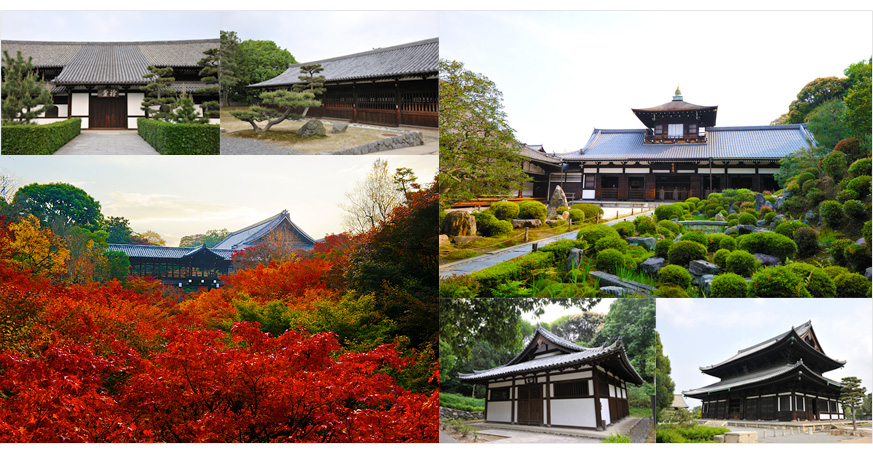 The Sanmon gate, a National Treasure, is the oldest Zen main gate in Japan. The Zendo (meditation hall), Tosu (lavatory) and Yokushitsu (bathing room) are also survivals from the early Muromachi period (14th century). The Hondo (main hall) and the Hojo (hear priest's quarters) are recent reconstructions. The valley up to the Kaisando, spanned by its three bridges, is famous for its maple leaves in autumn.
The Sanmon gate, a National Treasure, is the oldest Zen main gate in Japan. The Zendo (meditation hall), Tosu (lavatory) and Yokushitsu (bathing room) are also survivals from the early Muromachi period (14th century). The Hondo (main hall) and the Hojo (hear priest's quarters) are recent reconstructions. The valley up to the Kaisando, spanned by its three bridges, is famous for its maple leaves in autumn.
National Treasure, The Sammon Gate

Since the establishment the Temple met the fires as often as three times in 1319, 1334 and 1336 and the Sanmon Gate was burnt down. The present Sanmon Gate was rebuilt soon after the fires and completed in 1425. Since the re-establishment some minor repairing works were made on them. And in 1969 large-scale disassembling and repairing works were started in almost as many as 600 years since the initial building by the Ministry of Culture. It took eight years and nine months and also cost 2.5 million dollars until the refurbishing was completed in March, 1978.
The Gate was designated in 1952 to be one of the Japanese National Treasure Buildings. This is 22 meters high and two-storied. The construction is truly unique with the Great Budda's building method being applied and it is generally regarded to be one of the oldest, greatest and most gorgeous of all Zen Buddhist Temple Gates.
The framed picture on the tower was painted by the Tycoon Yoshimochi Ashikaga. The picture on the ceiling was drawn by Cho-Densu and Kan-Densu. The Sculpture of Budda on the front and sixteen Buddhist Monks are said to have been made by the Buddhist Teicho.
The Sanmon Gate is the most outstanding of, so-called, Tofukuji "Buddhist Temple Feature".
Tofuku-ji Temple Honbo garden (designated as a National Site of Scenic Beauty)
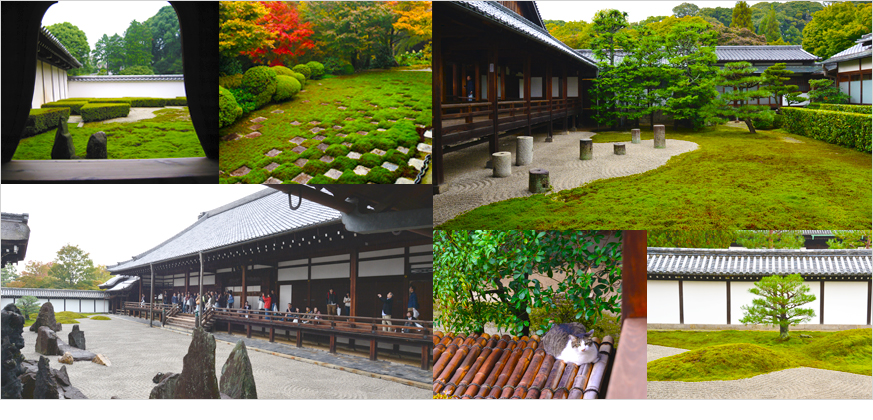
The Hojo, which is one of main building in the Tofukuji Temple founded in 1235, was reconstructed in 1890, and the gardens arranged at the four quarters around the building of Hojo were laid out in 1939 by Mr. Mirei Shigemori (a famous garden-builder), who intended to express the simplicity of Zen in the Kamakura period with the abstract construction of modern arts.
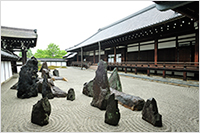
The southern garden
This garden in the front of Hojo is the most contrived work among the four gardens and is composed of four rock-composites symbolizing Elysian islands - from the east to the west named "Eiju, Horai, Koryo, and Hojo" - placed on the sand garden-floor "Hakkai" (meaning the eight rough seas) and five moss-covered sacred mountains at the right corner, the west side.
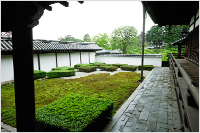
The western garden
Compared with rigidity of the southern garden's Zen-style (dry stone-garden), this garden has a gentle style composed of moss and azalea-shrubs trimmed in a chequered pattern in imitation of "Seiden", a Chinese way deviding the land.
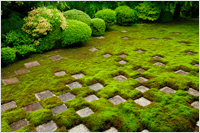
The northern garden
Square-cutted stones and moss are distributed in a small-sized chequered pattern. This garden faced on the "Tsuten" bridge and gorge noted as an autumn-tinted valley "Sengyokukan".
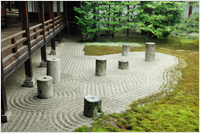
The eastern garden
Seven cylindrical stones are arranged in the moss field so as to represent main stars of the Great Bear of the heaven. These stones were originally foundation-stones used at the other place in the temple.
Tofukuji Temple Map
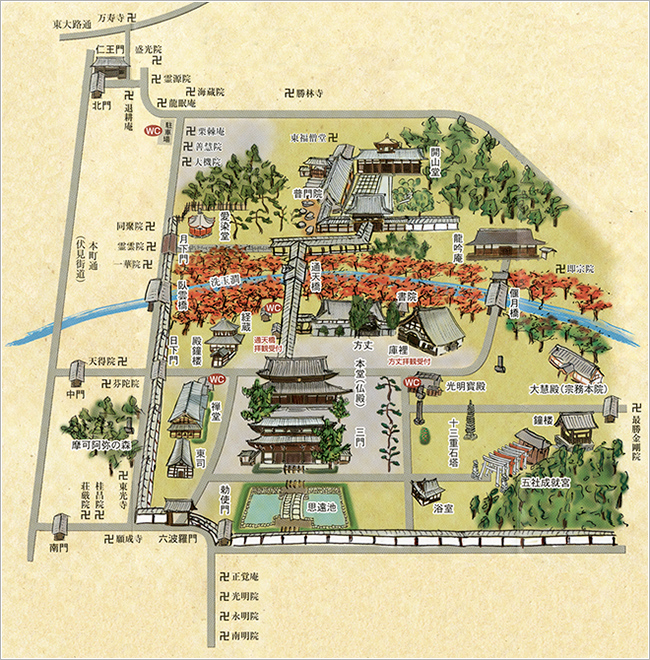

Access Map
Tofuku-ji Temple is located on the eastern side of Kyoto between Kujo-dori and Jujo-dori.
The Tofuku-ji station of Japan Rail as well as the Keihan electric railway are the closest rail stations to the temple to the southeast of the station.
Bus 6 or 16 from Shijo-Karasuma also serves the temple.
The temple is 1 mile (1.6km) southeast of Kyoto Station, and is open from 9:00 a.m. to 4:00 p.m. Entry fee.




